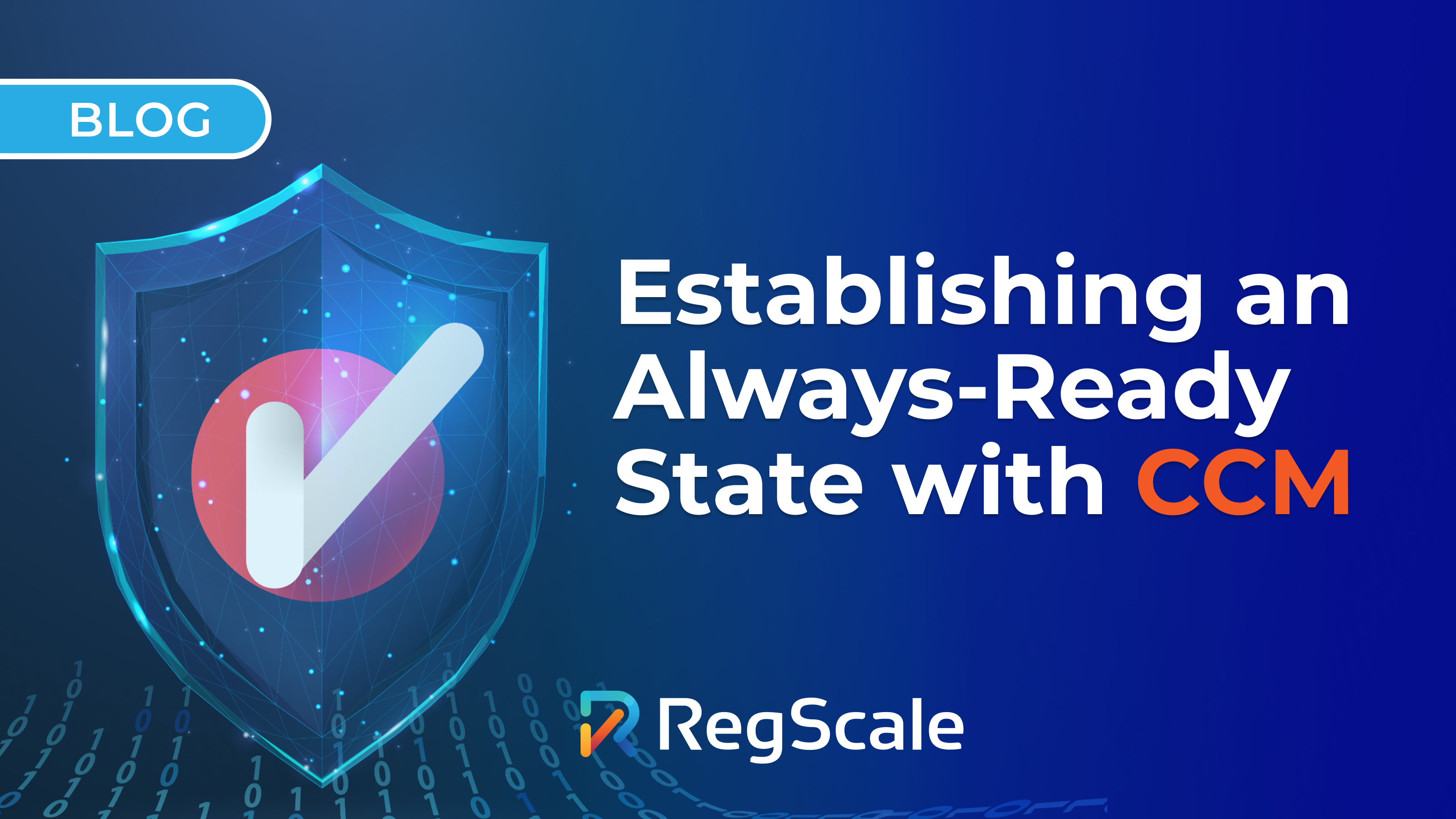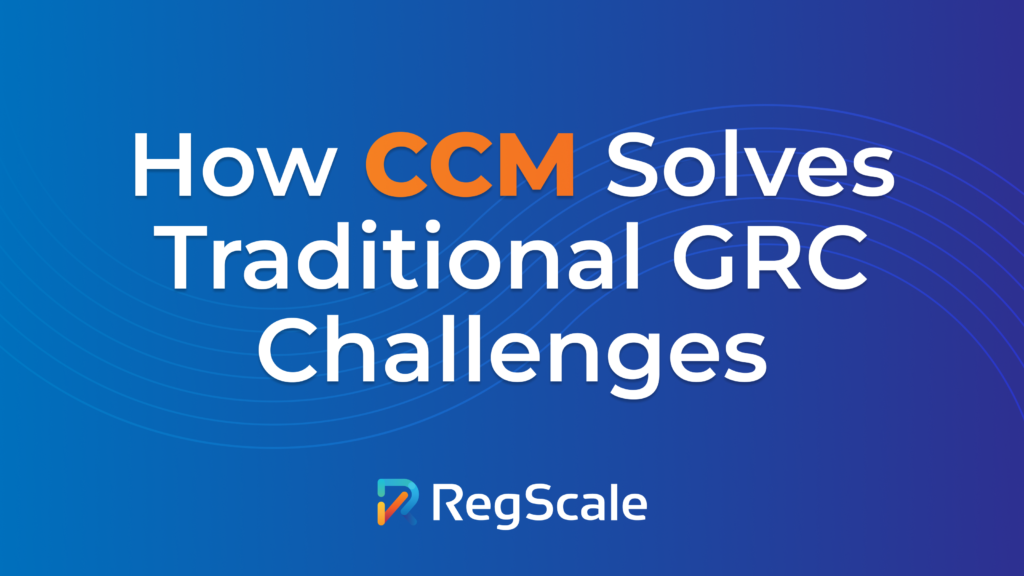Establishing an Always-Ready State with Continuous Controls Monitoring

Securing and maintaining compliance has become increasingly challenging. Organizations must be agile, proactive, and continuously prepared to address evolving threats and regulatory demands. Are you looking for a way to stay ahead of these challenges? Continuous Controls Monitoring (CCM) offers a game-changing solution, establishing an “always-ready state” that enhances governance, risk management, and compliance (GRC). But don’t take it from us. Dr. Edward Amoroso, Founder and CEO of TAG Cyber developed this recent white paper, that delves into how CCM achieves this always-ready state and the benefits it brings. Let’s begin exploring CCM.
Understanding the always-ready state
The always-ready state refers to continuous preparedness in managing compliance and security requirements. Traditional methods often involve periodic assessments and manual processes, such as:
- Gathering and documenting compliance evidence
- Conducting internal audits and reviews
- Manually tracking control effectiveness
- Updating compliance documentation
- Identifying and mitigating risks
These tasks are time-consuming and prone to errors. By contrast, the always-ready state emphasizes real-time monitoring and automation, ensuring that organizations maintain compliance and security without the need for extensive manual intervention.
CCM achieves this by automating routine compliance tasks, significantly reducing manual workload and minimizing errors. By leveraging AI and compliance as code, CCM ensures that compliance processes are seamlessly maintained and up to date. This continuous monitoring provides an accurate, real-time snapshot of an organization’s compliance status, enabling more informed decisions and proactive risk management. Through real-time insights, organizations can swiftly adapt to regulatory changes and maintain a strong compliance posture.
The role of automation and AI
Automation and artificial intelligence (AI) are fundamental to CCM, enabling platforms to continuously monitor and assess compliance controls in real-time. This reduces the need for manual intervention and significantly minimizes human error. By automating audit preparation and ongoing compliance activities, CCM makes the process more efficient and reliable.
CCM platforms like RegScale provide real-time updates and automation, streamlining compliance tasks and ensuring organizations stay ahead of regulatory changes. This continuous oversight improves accuracy and frees valuable resources for other critical tasks, such as performing in-depth control gap analysis, implementing control improvements, conducting proactive risk assessments, and preparing for audits. For example, RegScale’s CCM platform supports compliance frameworks like ISO 27001, SOC 2, FedRAMP, CMMC, and HIPAA, ensuring that your organization meets diverse regulatory requirements effectively.
For an in-depth look at how automation enhances compliance, explore the benefits of Automated Evidence Collection.
Enhancing real-time monitoring
Real-time monitoring is crucial for maintaining an always-ready state of compliance and security. Traditional security measures often fall short as they rely on periodic checks that can overlook emerging threats. CCM addresses this gap by providing continuous oversight of compliance controls, allowing organizations to identify and mitigate risks instantly. This proactive approach ensures compliance requirements are consistently met and enhances overall security.
CCM platforms deliver continuous, real-time monitoring, enabling immediate detection and response to potential compliance issues. This capability is essential for maintaining an always-ready state, ensuring ongoing vigilance and rapid adaptation to new threats and regulatory changes. For instance, CCM can continuously monitor compliance with standards like NIST SP 800-53, PCI-DSS, and GDPR, providing assurance that your organization remains compliant with these critical regulations.
Improving data integration and management
Disjointed data across multiple systems can complicate compliance efforts and hinder effective risk management. CCM platforms effectively tackle this challenge by integrating data from various sources, such as vulnerability scanners, SIEM systems, and configuration management databases. By providing a unified view of compliance and risk management activities, these platforms enhance decision-making capabilities. This holistic approach ensures data accuracy and consistency, allowing organizations to promptly address threats and maintain strong security and compliance postures.
CCM platforms continuously aggregate and update data, offering a consolidated view, streamlining compliance reporting, and improving overall data accuracy. By maintaining accurate and up-to-date compliance information, organizations can make more informed decisions, reduce manual data handling, and enhance their overall risk management strategies. This integrated approach simplifies compliance processes and mitigates the risks of fragmented data environments. For example, integrating data to comply with frameworks like SOX and COBIT becomes more manageable with CCM.
For a detailed example of how CCM achieves this, explore Continuous Compliance for DevSecOps.
Achieving efficiency and cost savings
Manual compliance processes are not only time-consuming but also costly. Organizations frequently face substantial expenses in labor, time, and resources when meeting regulatory requirements through manual methods. Automating these processes with CCM leads to significant cost savings by streamlining compliance efforts and reducing dependency on manual tasks.
The automation and real-time insights provided by CCM platforms result in faster, more efficient compliance activities. Dr. Amoroso’s white paper highlights how CCM can cut audit preparation time by up to 60%, allowing resources to be reallocated to more strategic initiatives, such as:
- Enhancing cybersecurity defenses
- Developing new business applications
- Conducting in-depth risk assessments
- Innovating and improving products and services
- Strengthening customer relationships and engagement
This efficiency boosts overall productivity and reduces the operational costs associated with compliance management. By minimizing manual interventions and optimizing compliance workflows, CCM offers a cost-effective approach to maintaining regulatory standards across various frameworks like ISO 27001, SOC 2, and FedRAMP.
Read more information on how to shorten time to market.
The benefits of a proactive risk management approach
Traditional risk management approaches are often reactive and fail to provide a comprehensive view of an organization’s risk posture. This reactive stance can leave organizations vulnerable to emerging threats and compliance gaps. CCM offers a proactive approach, continuously monitoring and assessing risks to provide real-time insights and facilitate timely interventions.
CCM helps organizations stay ahead of potential threats by maintaining continuous oversight of compliance controls, ensuring that risks are identified and mitigated instantly. This proactive approach enhances the organization’s security posture and consistently meets compliance requirements. The white paper emphasizes that proactive risk management with CCM allows for timely interventions maintaining robust security and compliance standards. For example, proactive risk management using CCM ensures compliance with standards like NIST SP 800-171 and CMMC, protecting sensitive information from emerging threats.
Optimizing security posture through continuous monitoring
Maintaining a strong security posture is an ongoing challenge for organizations. Traditional security measures often rely on periodic assessments and static controls, which may not provide the continuous oversight needed to address evolving threats effectively. This can leave security gaps and create vulnerabilities. CCM revolutionizes security by providing ongoing oversight and real-time visibility into security controls. Unlike traditional methods, which are often static, CCM ensures dynamic monitoring and adaptation to current threats.
Continuous readiness allows organizations to maintain compliance and proactively address security threats. The white paper emphasizes that continuous monitoring helps organizations identify and mitigate vulnerabilities immediately, resulting in a more resilient and adaptable security posture. This approach ensures that security measures are always up-to-date and capable of handling evolving cyber threats. To explore this approach more, see how to automate controls mapping in compliance and how it applies to frameworks like PCI-DSS and GDPR.
Why an always-ready state is essential
Establishing an always-ready state through CCM offers numerous benefits, including enhanced compliance, improved risk management, and significant cost savings. By leveraging automation, AI, and real-time monitoring, CCM enables organizations to maintain a robust security posture and stay ahead of regulatory changes.
Ready to enhance your compliance and risk management? Schedule a personalized demo with us. Our team will showcase our advanced CCM solutions, illustrating how you can achieve real-time oversight, cut down on manual work, and ensure continuous compliance. Step into the future of compliance management today.
Ready to get started?
Choose the path that is right for you!
Skip the line
My organization doesn’t have GRC tools yet and I am ready to start automating my compliance with continuous monitoring pipelines now.
Supercharge
My organization already has legacy compliance software, but I want to automate many of the manual processes that feed it.
